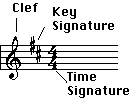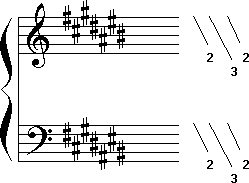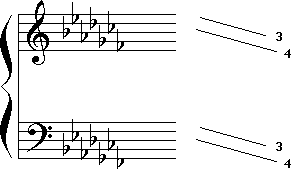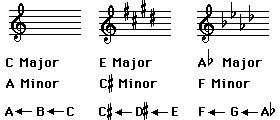
Key signatures appear on every line of music immediately to the right of the clef. The time signature appears on the very first line of music and not written again until it is changed. The clef and key signature appear at the beginning of every line of music. The key signature consists of one to seven sharps or flats. Key signatures are either all sharps or all flats, never mixed.

Key signatures and scales are closely related. For every major (and relative minor) scale there is a corresponding key signature with exactly the same sharps and flats that appear in the scale. The melodies and chords used in most pieces are based on the notes of a specific major or minor scale and the key signature is used to specify those sharps and flats. The use of key signatures probably came about so that composers would not have to write sharps and flats so often. The sharps and flats that appear in the key signature affect every note of that name in the entire piece, no matter what octave the note appears in.
Here's a melody written without a key signature.

Here's the same melody in the key of E. It's much easier for the composer to write and for performer to read.

Key signatures use from zero to seven sharps or zero to seven flats. The number of sharps or flats in the key signature correspond precisely to the major or natural minor scale with the same number of sharps or flats in the scale.
The names of the major keys using sharps in the key signature follow the ascending circle of fifths: C G D A E B F# C#. As each new sharp is added to the scale, previously used sharps remain in effect.
| Key
|
Number
of Sharps |
Key
Signature |
Scale |
| C
Major |
0 |
 |
|
| G
Major |
1 |
 |
 |
| D
Major |
2 |
 |
|
| A
Major |
3 |
 |
 |
| E
Major |
4 |
 |
|
| B
Major |
5 |
 |
 |
| F#
Major |
6 |
 |
|
| C#
Major |
7 |
 |
|
As the number of sharps in a key signature increases, previously used sharps remain in effect.
Major Key |
Minor Key |
Sharps |
1 | 2 | 3 | 4 | 5 | 6 | 7 | Key Signature |
C |
A |
0 |
 |
|||||||
G |
E |
1 |
F# |  |
||||||
D |
B |
2 |
F# | C# |  |
|||||
A |
F# |
3 |
F# | C# | G# |  |
||||
E |
C# |
4 |
F# | C# | G# | D# |  |
|||
B |
G# |
5 |
F# | C# | G# | D# | A# |  |
||
F# |
D# |
6 |
F# | C# | G# | D# | A# | E# |  |
|
C# |
A# |
7 |
F# | C# | G# | D# | A# | E# | B# |  |
The names of major keys using flats in the key signature follow the descending circle of fifths: C F Bb Eb Ab Db Gb Cb. As each new flat is added to the scale, previously used flats remain in effect.
| Key |
Number
of Flats |
Key Signature |
Scale |
| C Major |
0 |
 |
|
| F Major |
1 |
 |
 |
| Bb Major |
2 |
 |
 |
| Eb Major |
3 |
 |
 |
| Ab Major |
4 |
 |
 |
| Db Major |
5 |
 |
|
| Gb Major |
6 |
 |
 |
| Cb Major |
7 |
 |
|
As the number of flats in a key signature increases, previously used flats remain in effect.
Major Key |
Minor Key |
Flats |
1 | 2 | 3 | 4 | 5 | 6 | 7 | Key Signature |
C |
A |
0 |
 |
|||||||
F |
D |
1 |
Bb |  |
||||||
Bb |
G |
2 |
Bb | Eb |  |
|||||
Eb |
C |
3 |
Bb | Eb | Ab |  |
||||
Ab |
F |
4 |
Bb | Eb | Ab | Db |  |
|||
Db |
Bb |
5 |
Bb | Eb | Ab | Db | Gb |  |
||
Gb |
Eb |
6 |
Bb | Eb | Ab | Db | Gb | Cb |  |
|
Cb |
Ab |
7 |
Bb | Eb | Ab | Db | Gb | Cb | Fb |  |
Minor keys use the key signature of the relative major key.
The names of minor keys using sharps in the key signature follow the ascending circle of fifths: a e b f# c# g# d# a#.
| Key |
Number
of Sharps |
Key
Signature |
Scale |
| A minor |
0 |
 |
|
| E minor |
1 |
 |
 |
| B minor |
2 |
 |
|
| F# minor |
3 |
 |
 |
| C# minor |
4 |
 |
 |
| G# minor |
5 |
 |
 |
| D# minor |
6 |
 |
|
| A# minor |
7 |
 |
 |
The names of minor keys using flats in the key signature follow the ascending circle of fifths: a d g c f bb eb Ab.
| Key
|
Number
of Flats |
Key
Signature |
Scale |
| A minor |
0 |
 |
|
| D minor |
1 |
 |
|
| G minor |
2 |
 |
 |
| C minor |
3 |
 |
|
| F minor |
4 |
 |
 |
| Bb minor |
5 |
 |
 |
| Eb minor |
6 |
 |
 |
| Ab minor |
7 |
 |
 |
The rules for determining major sharp keys are:
1. The key of C major has no sharps
or flats.
2. For key signatures having one to seven sharps, the name of the major key
is one half step (minor second) higher than the last sharp (the sharp furthest
to the right) of the key signature.

The order that sharps appear in the key signature follow the clockwise (ascending) circle of fifths beginning with F sharp and continuing to B sharp.

Sharps in a key signatures are always drawn on the following staff lines and spaces. Note the diagonal arrangement from top to bottom left to right. They never switch octaves.

The rules for determining major
flat keys are:
1. The key of C major has no sharps or flats.
2. The key of F major has one flat.
3. For key signatures having two to seven flats, the name of the major key
is the name of the next to the last flat (the flat 2nd from the right) of
the key signature.

The order that flats appear in the key signature follow the descending circle of fifths beginning with B flat and continuing to F flat.

Flats in a key signatures are always drawn in a specific order. Note the diagonal arrangement from top to bottom left to right.

To find the name of the minor key signature, first determine the name of the major key signature and then count backwards three scale notes. Sharps and flats present in the key signature affect the key name.

You can also remember key signatures by relating the last (right most) accidental of the key signature to scale degrees.
Sharps
Major - The last sharp is the leading tone of the key.
Minor - The last sharp is the supertonic of the key.
Flats
Major - The last flat is the subdominant of the key.
Minor - The last flat is the submediant of the key.
Relative keys are major and minor keys that have different names, but share the same key signature. For example, E minor is the relative minor of G major and A flat major is the relative major of F minor.

Parallel keys are major and minor keys that have the same name, but use different key signatures. For example, B minor is the parallel minor of B major, and B major is the parallel major of B minor.

Revised by John Ellinger, Spring 2012.